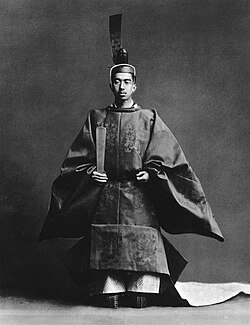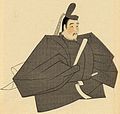Hu (ritual baton)

Shaku (笏) is the Japanese name for a flat ritual baton or scepter of Chinese origin. Usually made of woods like Japanese yew, holly, cherry, sakaki or Japanese cedar[1], the shaku is often seen in portraits of shoguns and noblemen but is now used mostly by Shinto priests (the kannushi).
The use of the shaku as a ritual baton originated in ancient China, where in mandarin it is called hù with the same Chinese character.[2] The standard reading for the character used to write shaku is kotsu, but that is also one of the readings for the character bone (骨, hone) and is thus avoided to prevent bad luck.[1] The character's unusual pronunciation seems to derive from the fact the baton is approximately one shaku (an old unit of measurement equivalent to 30.3 cm) in length.[1]
Origins and evolution
A shaku or teita (手板) is a baton or scepter about 35 cm long held vertically in the right hand, and was traditionally part of a nobleman's formal attire (the sokutai, see photo).[3] Today it is used however mostly by Shinto priests during functions, not only with a sokutai but with other types of formal clothing as the Jōe, the kariginu (狩衣) and the ikan (衣冠).[1][3] The Emperor's shaku is more or less square at both ends, while a retainer's is rounded above and square at the bottom.[4] Both become progressively narrow towards the bottom.[4] Oak is considered the best, followed in order by holly, cherry, sakaki and Japanese cedar.[4]
The shaku originally had a strip of paper attached to the back containing instructions and memoranda for the ceremony or event about to take place, but it later evolved into a purely ceremonial implement meant to add solemnity to rituals.[1] According to the Taiho Code, a set of administrative laws implemented in the year 701, nobles of the fifth rank and above had to use an ivory shaku, while those below that rank were to use oak, Japanese yew, holly, cherry, sakaki, Japanese cedar, or other woods.[1][3] Ivory, however, was too hard to obtain, and the law was changed.[4] The Engishiki, a Japanese book of laws and regulations written in 927, permits to all the use of shaku of unfinished wood, except when wearing special ceremonial clothes called reifuku (礼服).[1][3]
Gallery
-
Shogun Minamoto no Sanetomo
-
Two kannushi in Kyoto
References
- ^ a b c d e f g Iwanami Kōjien (広辞苑) Japanese dictionary, 6th Edition (2008), DVD version
- ^ Classic of Rites: "笏長二尺六寸,中宽三寸。" (Hù (笏) has a length of two chǐ six cùn, (and its) mid part has a width of three cùn) - the earliest standard for Shaku.
- ^ a b c d Encyclopedia of Shinto. "Shaku". Kokugakuin University. Retrieved 2009-10-06.
- ^ a b c d Takada, Shizuo. "Shaku". Nihon Daihyakka Zensho Online (in Japanese). Shogakukan. Retrieved 2009-10-13.



